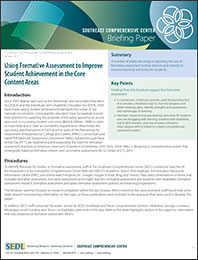Using Formative Assessment to Improve Student Achievement in the Core Content Areas: Southeast Comprehensive Center Briefing Paper, January 2012

Authors: Robyn Madison-Harris, Ada Muoneke, Chris Times
| Price: Available free online |
Available online: Full text
![]()
Since 2001, federal laws such as the Elementary and Secondary Education Act (ESEA) and the Individuals with Disabilities Education Act (IDEA) 2004 have made raising student achievement standards the center of our national conversation. Consequently, educators have increasingly turned their attention to exploring the potential of formative assessments as one approach to increasing student outcomes (Black & William, 1998) in order to meet federal and state accountability requirements. Meanwhile, the upcoming reauthorization of ESEA and the work of the Partnership for Assessment of Readiness for College and Careers (PARCC) consortium and SMARTER Balanced Assessment Consortium (SBAC), funded through Race to the Top (RTT), are heightening and expanding the need for formative assessment practices in American classrooms (Davidson & Frohbieter, 2011; Dorn, 2010). SBAC is designing a comprehensive system that strategically balances formative, interim, and summative assessments (K–12 Center at ETS, 2011).
